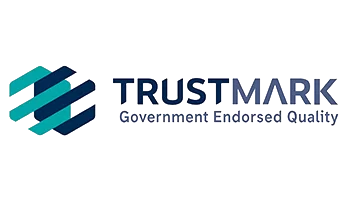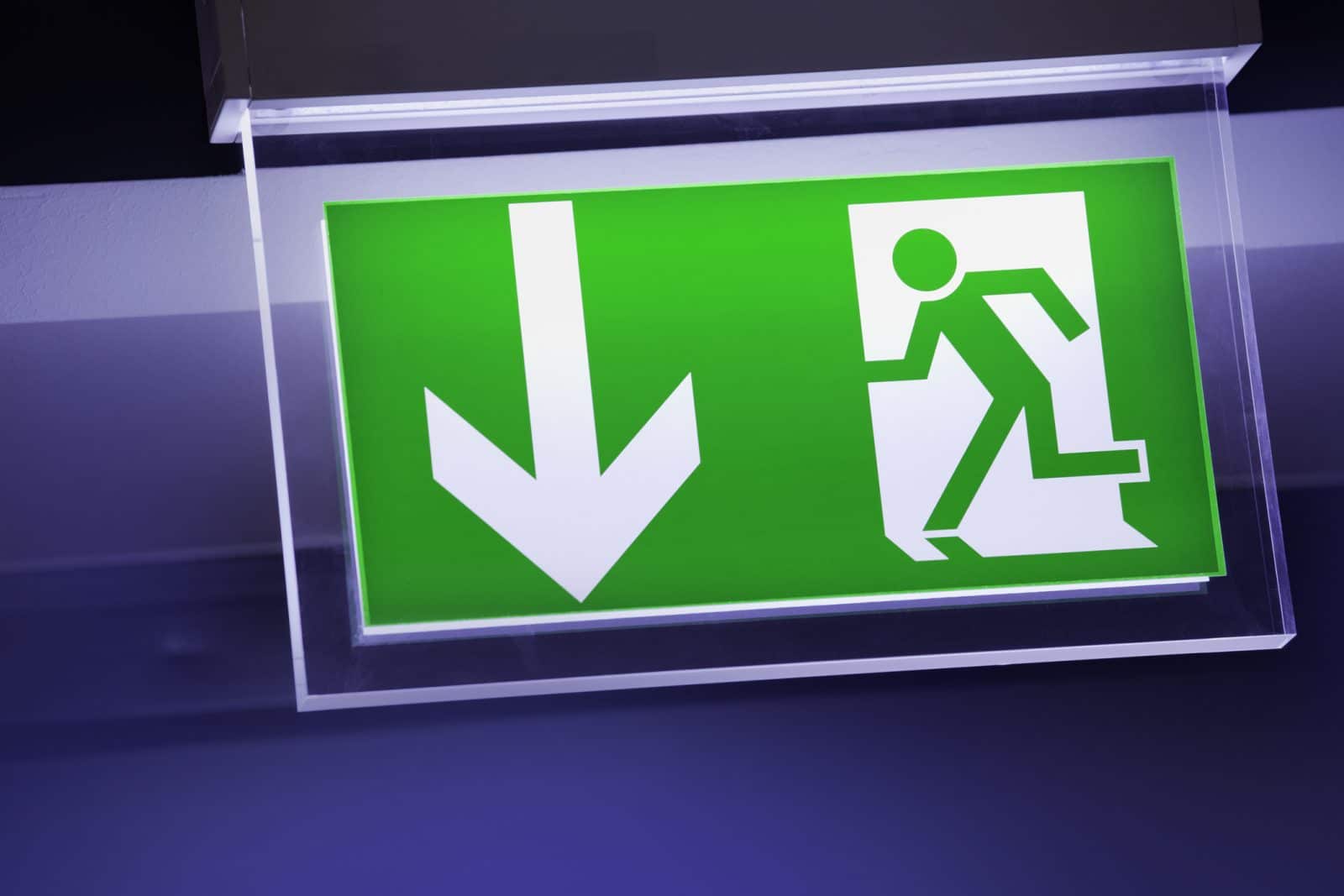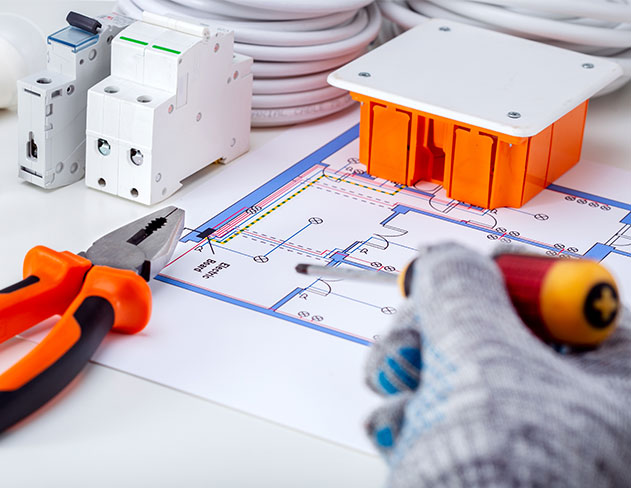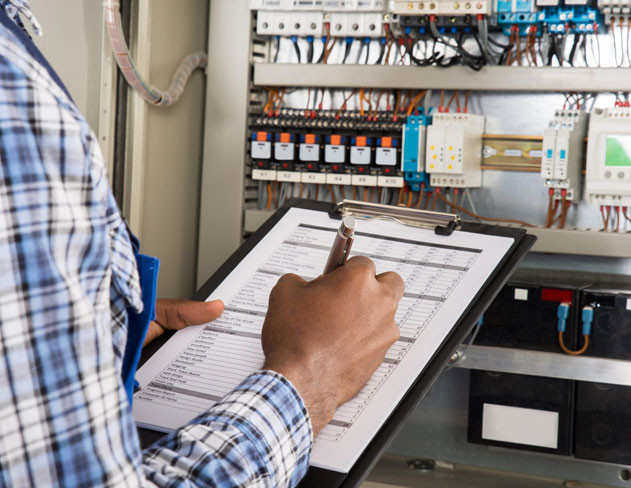






Emergency Light Testing
At Hexo Electrical Testing, we offer comprehensive emergency lighting testing in London and the South East. This is a crucial aspect of building maintenance, as emergency lighting provides illumination in the event of the mains power failure and power outage.
It is a requirement of the fire safety regulations that, as a minimum, all exit routes are always adequately illuminated and have the correct signage. Therefore, an emergency lighting test certificate that shows the system is working properly is critical for proving your legal compliance.
Who Can Test Emergency Lighting?
Given the importance of the emergency lighting testing and the severity of the issues, we do not recommend self-testing if it does not work as expected when required.
Given the complexity of emergency equipment involved, it’s crucial to have a competent person handle the testing to ensure compliance with safety legislation.
By booking your London emergency lighting testing with a professional company like Hexo Electrical Testing, you can ensure that your business complies with all regulatory requirements.
How Does Emergency Light Testing Work?
With our services covering London and the South East, we will visit your site once per year to carry out an annual emergency light test and provide you with an emergency lighting test certificate showing the outcome of the test.
We will keep to an emergency lighting test schedule to check your emergency lights regularly to ensure the highest adherence to safety protocols.
As well as the annual tests and inspections, the emergency lighting system needs a briefer test each month. A trained operative at your premises can carry this out, or we can attend the site each month to carry out these tests.
Do You Know the Requirements for Emergency Light Testing?
Does your emergency lighting meet its legal requirements? When it comes to emergency lighting system testing, you can never be too thorough. So, what are the Emergency Lighting Testing requirements in England?
Understanding the requirements is crucial for the safety of people involved, especially in an emergency situation where the mains power supply may fail.
Whilst used hopefully infrequently, it is absolutely critical that emergency lighting is operational at all times, and having an emergency lighting test certificate ensures that this is the case.
To make sure your emergency lighting is operational at all times, you should engage the services of a specialist emergency lighting testing company such as Hexo Electrical Testing.
How Often Should My Emergency Lighting System Be Tested?
The emergency lighting system should be tested monthly to check its operation. It should also be tested annually to verify that it operates for the required duration and to verify the full compliance of the system so that you can have an up-to-date emergency lighting certificate.
The system should undergo tests of minimum duration as specified in safety legislation to ensure the reliability of your emergency escape lighting system.
At Hexo Electrical Testing, we offer monthly and annual comprehensive Emergency Light Testing in London and the South East of England, and our emergency lighting testing and servicing covers everything from ad hoc visits to monthly visits and annual inspections.
Monthly Emergency Lighting Tests
Emergency light testing needs to be carried out by a responsible person every month.
Each test involves turning off the mains supply via a single switch to simulate a power outage, ensuring that the emergency lighting activates as it should. This test will highlight emergency lighting that doesn’t light up when the main power is off. We will also:
- Examine all equipment for signs of disrepair
- Once power is back on, we will check to make sure each luminaire is charging
- We will maintain a monthly emergency light test safety logbook of our inspection results, keeping track of any issues or necessary repairs
We conduct a systematic monthly inspection to ensure all lighting is functioning correctly and in line with emergency lighting testing requirements.
Annual Emergency Lighting Test
As well as carrying out monthly tests, it is vital that more thorough emergency lighting testing is carried out once a year. This annual emergency lighting inspection in London involves a duration test to check that each emergency light remains clear and bright for the correct amount of time, usually 3 hours.
The annual test includes a thorough check of the lighting circuit and ensures that proper shut-down procedures are in place for each emergency lighting unit.
We can carry out annual emergency lighting testing in London on weekends or evenings to minimise disruption to your business.
What Is Checked in the Annual Emergency Lighting Inspections?
During the annual emergency lighting inspection, we examine the full installation and check that the following areas have adequate emergency illumination:
- Intersections of corridors
- Emergency escape routes
- Outside each final exit and on external escape routes
- Emergency escape signs
- Stairways (so that each flight receives adequate lighting)
- Changes in floor level
- Windowless rooms and toilet accommodation exceeding 8m²
- Fire-fighting equipment
- Fire alarm call points
- Equipment that would need to be shut down in an emergency
- Areas greater than 60m²
What will commercial emergency light testing reveal?
So, what does an emergency lighting test reveal? Our Commercial Emergency Light Testing service will highlight any defects that need to be rectified so that you can keep your property, employees, and customers safe.
Our complete emergency lighting system testing will ensure your system is BS 5266 compliant, we provide an annual inspection and duration testing, as well as regular monthly checks. Our comprehensive tests will reveal any issues with your power supply, light circuit, and whether your setup is safety compliant. We can help no matter what size or type of business you have.
- Lights that fail the duration test
- Lights that do not illuminate at all
- Areas not illuminated that need to be
- Damaged emergency lights
- Dim or flickering emergency lights
Commercial emergency lighting laws
There are certain regulatory requirements and emergency lighting laws that must be adhered to to ensure your commercial premises are properly protected with emergency escape lighting. These are:
- Guidance: This comes in the form of the BS 5266-1 Code of Practice for emergency lighting of premises, which gives general information and rules as to how emergency lighting should be installed and how it should operate in commercial premises
- System standards: The emergency lighting in your commercial premises must adhere to BS EN 1838 Lighting Applications – emergency lighting. This states the level of illumination that must be provided, including duration, colour, and luminance
- BS EN 50172 / BS 5266-8: The Emergency escape lighting systems standard specifies the testing requirements for emergency lighting in different premises
- Government legislation: The Regulatory Reform (Fire Safety) Order 2005 (RRFSO) stipulates what emergency escape lighting is required in the different types of non-domestic property and communal areas of houses of multiple occupations (HMOs). There are several guides available as part of the RRFSO which detail the individual requirements.
What Happens After the Emergency Light Testing?
After testing the emergency lighting system on your premises, we will issue you a Satisfactory Certificate (Pass) or an Unsatisfactory Certificate (Fail).
If the emergency lighting certificate is Unsatisfactory, then we will provide you with a schedule of defects and an itemised quotation to carry out the repairs needed to rectify the defects and bring the system up to a Satisfactory and compliant condition.
It is imperative that any necessary repair works highlighted by the emergency lighting inspection and test are actioned immediately, as you will likely be in breach of the Regulatory Reform (Fire Safety) Order 2005 if you do not.
This not only poses legal risks to your business, but ineffective emergency lighting also poses a very real danger to the health and safety of any building occupants.
How to Receive a Satisfactory Emergency Lighting Test Certificate
Once you have instructed us to rectify the defects, we will attend the site and complete the electrical repairs. We will then provide you with certification for the repairs themselves and a new Satisfactory Emergency Lighting Certificate for your legal compliance.
How Much Does Emergency Light Testing Cost?
So, how much does it cost to test emergency lighting? Our emergency light testing prices differ depending on the service required. However, we try to make emergency lighting inspection London costs as transparent as possible.
You can find a full breakdown of emergency lighting certificate costs, including monthly and annual prices, via our Emergency Light Testing Prices page, and it’s easy to make a booking. All prices include the emergency lighting inspection and test certificate.
What Emergency Lighting Should My Building Have?
There are two main types of emergency lighting:
Standby lighting
This lighting comes into action and illuminates the area if the standard lighting in the building fails. It allows the staff to carry on with their normal roles if there is no emergency that necessitates leaving the building.
This form of emergency lighting is not usually a legal requirement, as it may not be absolutely crucial to the safety of the workforce. It will depend on what activities are being carried out on the premises.
Emergency escape lighting
Your building should have an emergency escape lighting system that automatically activates if there is a failure in the normal lighting supply. This is a legal requirement in London and throughout the UK, as it will enable the occupants of a building to find their way to the nearest emergency exit safely. It should also provide enough illumination to stop any potentially dangerous tasks safely before evacuating.
This type of lighting is a requirement of the Regulatory (Fire Safety) Order 2005 and is part of the fire safety provision required for a building. Emergency escape lighting is split into different types of lighting as below:
- Escape route lighting– This will show any building occupants the way to the emergency exit so they can safely leave the building. It should be bright enough that any hazards along the way can be avoided and so that the exits are obvious to those in a high-pressure situation. It includes fire exit signs that are brightly illuminated and emergency bulkhead lights.
- Open area lighting– This lighting comes on in larger spaces so that the building occupants can find their way to the emergency escape route and the nearest exit. It is usually required in larger buildings.
- High-risk task area lighting– When working in an industry such as manufacturing, there is a high probability that certain processes and machinery would pose a risk if operated in the dark or left unattended at the time of evacuation. BS 5266-1 emergency lighting should come into action in these areas so that the task or process can be discontinued safely and all staff can evacuate the premises safely.
FAQs
Is Emergency Light Testing a Legal Requirement?
Yes. Thanks to the Regulatory Reform (Fire Safety) Order 2005, Emergency Light Testing requirements are compulsory for all non-domestic premises. The order also stipulates what lighting is required in different premises.
When should you carry out emergency light testing?
Emergency light testing should be carried out at a safe time when the emergency lighting is not likely to be needed, as during the inspection and test, the batteries of the emergency lighting will be diminished. So, it’s important to identify a low-risk time to have the inspection carried out.
Normal lighting levels may be reduced while the test is carried out, so the test must be scheduled for a suitable time around your business operations.
Why is emergency light testing important?
If the worst happens, your emergency lighting must immediately trigger into action. If not, the workplace will be plunged into darkness, posing several safety problems and making it difficult for occupants to evacuate the building safely.
So, not only is having an emergency lighting test certificate necessary, but when building evacuation happens, the workforce needs to be able to see where the exit signs are to navigate to safety.






